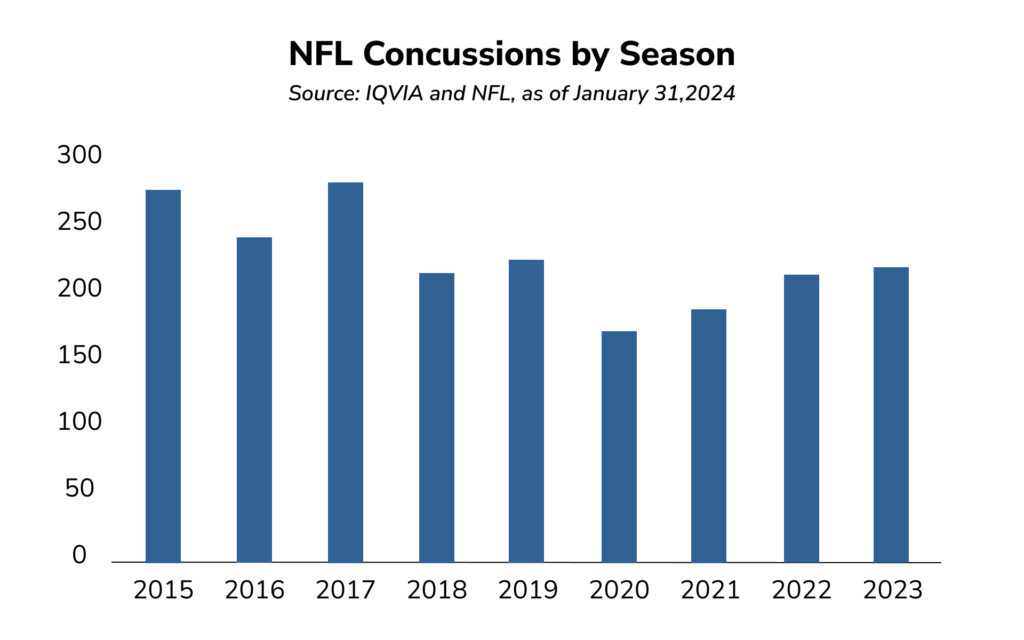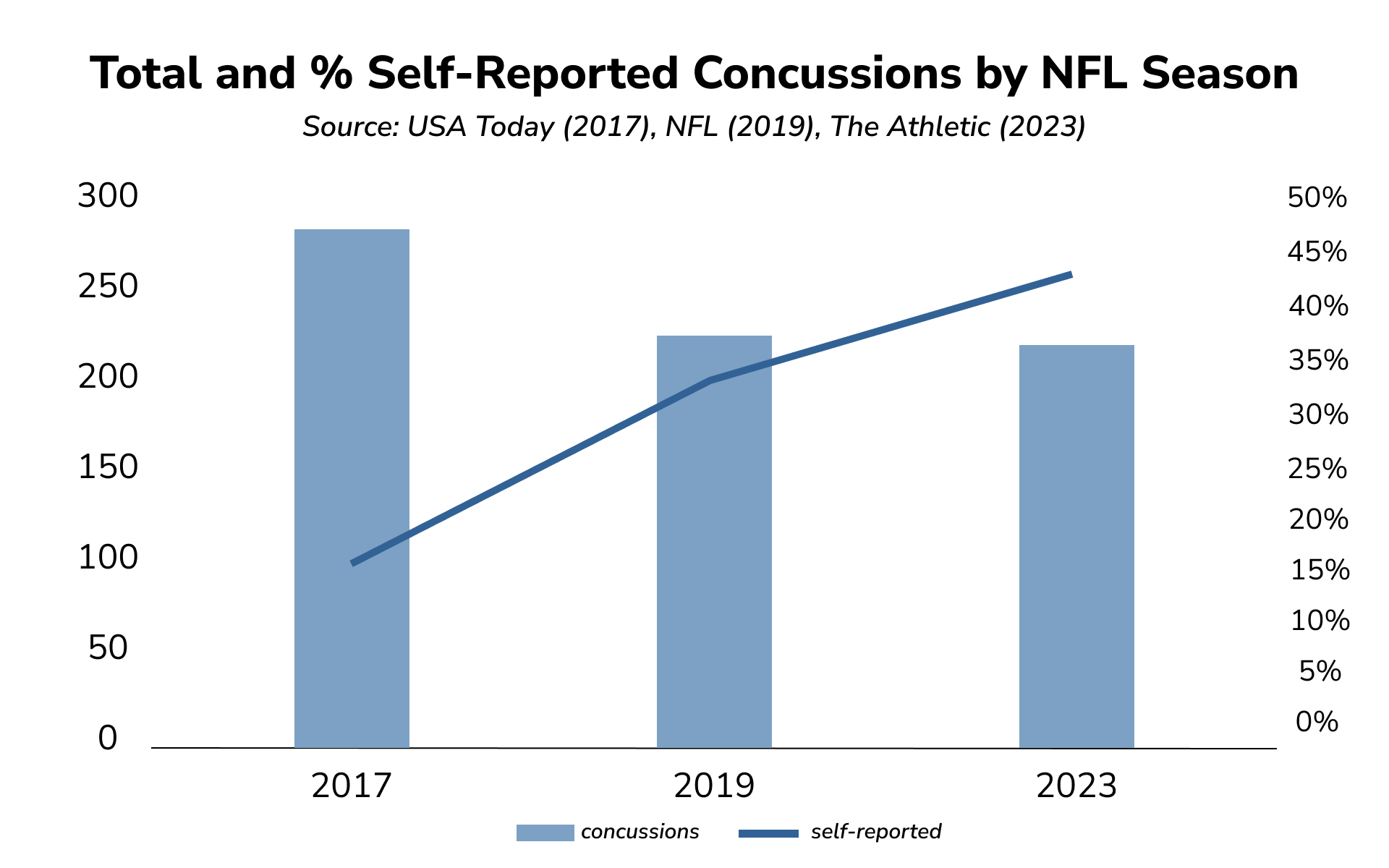This Sunday, almost 75% of Americans could tune in to watch 22 men play the tough, thrilling game we know as football. The game marks the end of a season of great entertainment, highs and lows, and the making of some of the biggest stars with the biggest moments, including Taylor Swift cheering in the stands.
The game also has a tough reality: it comes with a risk of injury. The NFL is aware of this, keeps close track of these injuries, and has a plan. We think we can help improve on that plan, moving this game to even safer territory.
The reality: A game many love
At the end of each season the NFL releases its annual injury report. Compiled by IQVIA, a healthcare data company, the report is essentially a report card for injuries during the season within the league. Naturally, it includes data on the incidence of concussion, as well as updates on the protocols in place for concussion identification and prevention. The release of the latest report reveals that the number of concussions for the 2023 season increased slightly.
That persistence of concussion within the NFL – and football generally – is no surprise given the nature of the sport and the size and athleticism of its players. Yet despite its hazards, the NFL is unequaled among major sports in terms of fan interest and TV ratings. Which means it’s not going anywhere. So, making progress on concussion in the NFL today means dealing with the facts at hand, and evaluating and improving the concussion protocol in use.
The trend: Downward but creeping back up
The overall incidence of concussions in the NFL has been decreasing from its 2017 peak.

And while the general concussion trend is downward, the most recent four years have seen the numbers creeping back up. Part of this upward drift may be attributable to what Jeff Miller, the NFL’s Executive Vice President of Player Health and Safety describes as the “increasingly conservative nature in which we examine and diagnose players.” In other words, even if the number of concussions remains flat, the numbers would look like they are increasing because they are more frequently diagnosed.
Another reason for the increase may lie with the players themselves, with the data showing a rise in the percent of NFL players who self-report concussion. Indeed, while the total number of concussions decreased from 2017 to 2023, the percent that were self-reported by players constituted a larger percentage of the total.
The rise in self-reporting is a positive development likely attributable to a pair of factors. The first is players’ increased awareness of the symptoms of concussion. Second, their increased concern about its long-term effects. As Dr. Alan Sills, the NFL’s Chief Medical Officer, said in 2020, “All of us perceive that the culture of self-reporting continues to grow and continues to change because players understand the magnitude of the injury.”

Better diagnosis and more self-reporting are both positive developments. But there are still challenges, and room to improve, including additional improvements in the area of diagnosis (more on that in a bit).
Despite progress, there remains resistance to self-reporting as players may see a concussion diagnosis as potentially career limiting, not to mention the pure love of competition. Evidence of their resistance can be seen in the reaction of players like Seattle’s Jamal Adams who last season took strong issue with the assessment of him by the game’s Unaffiliated Neurotrauma Consultant (UNC), an independent physician employed by the NFL to assess potentially concussed players during games.
Mindful of the toll it takes on the players and the league, Sills’ goal regarding concussion is simple and summed up in a recent statement by him: “We want to see them go down.” Of course, we all agree.
The plan: Focused on prevention
In a February 2024 article in The Athletic, the NFL says its focus is two-fold: 1) Reduce the volume of head impacts, particularly among offensive and defensive linemen; and 2) Reduce “high-risk, high-velocity” head impacts, which typically occur when players are tackling in space. That is, a player tackling a ball-carrier in the open field, relatively far away from other players. The NFL’s plan to do so revolves around education, enforcement, and equipment.
The assist: Taking the plan to the next level
The NFL’s prevention-focused strategy is commendable and may continue paying dividends. But we believe there’s also progress to be made in the area of diagnosis. We agree with Dr. Sills when he says “I retain an extremely high degree of confidence in the men and women that help us administer our concussion protocol. … We’re not perfect, but I think we’ve set a very high bar and standard for ourselves.” We think an additional, non-subjective, FDA-approved test to aid in the diagnosis of concussion can help the NFL reach that high bar.
Our firm, Oculogica, has developed and manufactured a device that fits that description. It’s called EyeBOX. It is backed by research and peer reviewed. It requires no pre-injury baseline data, is non-invasive, portable, and provides an immediate result.
Football is deeply woven into the fabric of American life. We mark time by its seasons and enjoy it in the company of those we care about. Helping ensure the long-term health of players will ensure that a sport loved by so many will continue to thrive. We at Oculogica want to be a part of its future and are ready to serve the players, and the league.
Safe game on Sunday gentlemen.
